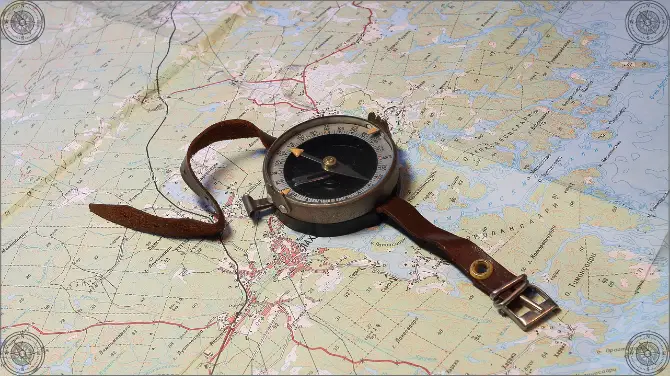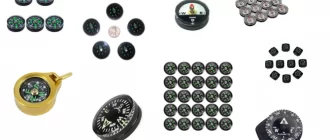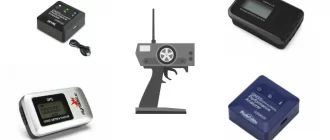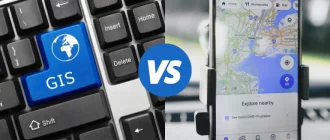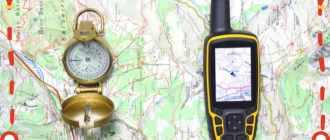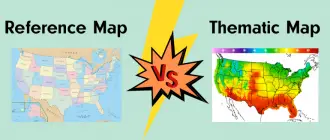If you are planning to go hiking or mountain biking in a national park having a wrist compass is an absolute must, especially if you are not familiar with the area and are relying on maps to find your way around. It is very easy to get lost on trials.
National Geographic says that the compass was invented in China over 2,000 years ago.
I researched more than 60 products and found seven that I really like, plus three more that almost made the list of the top choices. These compass choices are also good, just not as good as others on my review list:
A wrist compass can be very handy if it is rugged and strapped on for trekking over rigorous terrain, especially if you are a paratrooper. Bryan Suits found one in an antique store that dates back to 1944 that he repaired. Modern ones are sleeker but basically have the same function of helping someone keep from getting lost.
I found a WW2 paratrooper wrist compass in a Tehachapi antique store last year. I’m cleaning it and refilling it with mineral oil this morning and sure enough, SEP 1944 manufacture. Rochester, NY. (Unlikely that it was at Oper. Market-Garden. Prolly unissued. (New strap) pic.twitter.com/BcZOBBpfXZ
— Bryan Suits (@darksecretplace) January 19, 2020
After reading this article, you will know how to select and use a compass, so you can choose the best wrist compass that suits your needs, including understanding the important details about the following:
- Price
- Quality
- Features
The best wrist compass has a lot of competition for the top spot. There were many dozens of choices. I narrowed them down to just seven and picked my favorite as the top pick, with two others as also good choices. I once was saved by my wrist compass when hiking when I got completely lost in a sudden snowstorm.
The snow-covered all the reference points that I could have used. My battery in my GPS locator also went dead when the unit got wet, and I did not carry a replacement battery with me. Without a solid wrist compass to guide me back, I might still be lost in the snow and would not be able to write this review.
My Top Pick
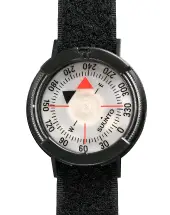 SUUNTO M-9
SUUNTO M-9
What’s Inside?
- Rugged design
- Balanced for the northern hemisphere
- Made in Finland
- Velcro wrist strap
- No batteries required
Killer Feature: The style is popular and it is comfortable to wear
Buying Options
This compass is my favorite because it is not complex, it is modestly priced (less than $25), and it gets the job done.
Also Great
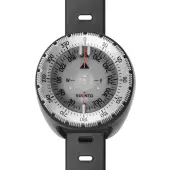 SUUNTO SK-8
SUUNTO SK-8
What’s Inside?
- Available for both northern and southern hemisphere use
- High-quality dive compass
- Easy-to-read with a phosphorescent compass card
- Waterproof
- Multiple attachment styles
Killer Feature: The firm-grip bezel has a ratchet at every five degrees
Buying Options
The Suunto company is known for its ultra-durable compasses made with advanced engineering that are simple to use.
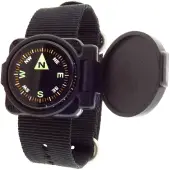 Sun Company ArmArmour 1
Sun Company ArmArmour 1
What’s Inside?
- Rugged tactical strap
- Luminous compass that is easy to read in low light conditions
- Rugged ABS housing
- Protective hinged cover
- Hardware is brushed stainless steel
Killer Feature: Comes with an adjustable strap that fits most adults and children
Buying Options
This compass is my favorite bargain choice for under $20.
Buyer’s Guide
The buyer’s guide contains the steps to help you choose the best wrist compass for your needs.
Point 1: Durability
A well-built compass will last a very long time as long as it is not near any magnets. Single Track World readers say that keeping a compass near a mobile phone can ruin it, so be careful about putting a compass in your pocket or bag next to a mobile phone.
You want to make sure the case is strong enough to withstand any bumps while wearing it on your wrist. The compass mustn’t easily break when dropped. If you take care of your compass, it may provide many decades of useful service.
Some compasses used by the military may become collectible items.
Scott Kerr found a vintage Silva ‘Globe Trotter’ wrist compass with a new wrist strap.
Vintage Silva ‘Globe Trotter’ wrist compass, dating from the mid 20th century.
“According to my watch, it’s half-past 45° NE” pic.twitter.com/wuoDEH4zEm
— Scott Kerr (@scott_kerr) June 19, 2021
Point 2: Compass Accuracy
You want to make sure your compass gives accurate readings and that you know how to use it properly.
Did you know that magnetic north and true north are different? And, the difference varies depending on the area? Maps align to true north. American Hiking describes the process of adjusting a compass using declination to set the true north direction as an offset from the magnetic north that depends on where you are.
Tips from Section Hiker tell us that you should find the proper magnetic declination, before you start a hiking trip. Also, you should know that local attraction to iron or nickel metal deposits in the land, high-voltage power lines, metal automobile bodies, and large flashlight batteries will influence a compass too.
People who do not know how to set the declination and rely on inaccurate compass readings can easily get lost.
Point 3: Waterproof
If you use a compass for diving or in wet conditions, you want to make sure it is waterproof. Waterproofing is critical for diving, which is different than being water-resistant. Be sure to check the rating of any compass you consider for the waterproofing at the depth you plan to dive.
A wrist compass has come a long way since the 1970s with many modern improvements.
Wrist compass, USSR, 1970s pic.twitter.com/ns7ZlYflp5
— Soviet Visuals (@sovietvisuals) April 24, 2019
This quick list describes the killer feature of each candidate for the best wrist compass to help you narrow down your choices rapidly, and then you can read the in-depth reviews of those you like.
 |
1. SUUNTO M-9 →The Suunto company has an authentic heritage and was founded in 1936. My Top Pick |
|
 |
2. SUUNTO SK-8 →The firm-grip bezel has a ratchet at every five degrees. Also Great |
|
 |
3. Sun Company ArmArmour 1 →Comes with an adjustable strap that fits most adults and children. Also Great |
|
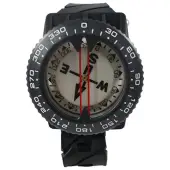 |
4. Scuba Choice Deluxe →This compass works for deep diving with a maximum depth of 80 meters. |
|
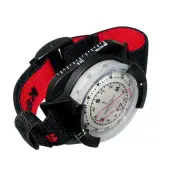 |
5. KanPas Wrist Compass →This compass is shockproof and waterproof to a depth of 60 meters. |
|
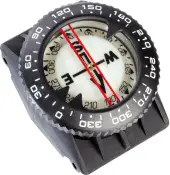 |
6. Cressi Underwater Compass →The face is luminous and divided into 10-degree intervals. |
|
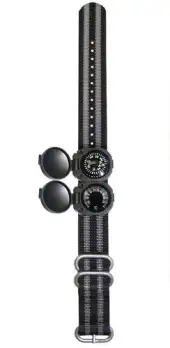 |
7. Sun Company ArmArmour 3 →Comes with a grade-AA dial thermometer that reads down to minus 30 degrees Fahrenheit. |
A wrist compass will come in handy if you are trying to get a certification in global information systems (GIS). Get recommendations about the best GS certification programs here.
Here are the detailed reviews of the best wrist compass choices:
1. SUUNTO M-9
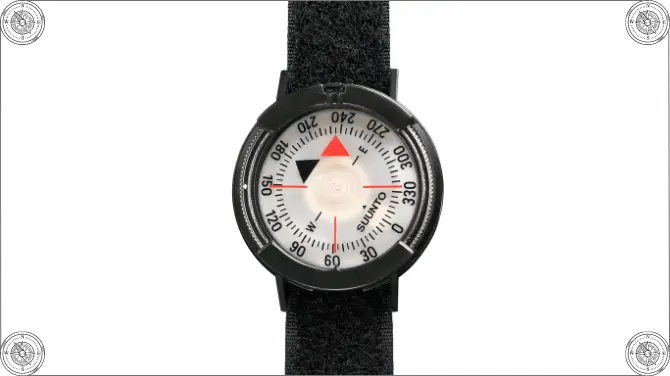
The Suunto M-9 comes with a Velcro wrist strap and is easy to read with a luminescent card. It has a rugged construction, built to take abuse. This compass, made in Finland, is waterproof and good for many outdoor activities like skiing, hiking, mountaineering, or diving.
Pros:
- Made with advanced engineering and durable materials.
- No batteries are required.
- Provides accurate navigation in the northern hemisphere.
- The Suunto company was founded over 80 years ago and is known for quality craftsmanship.
- Extremely accurate.
Cons:
- Must be in a level position to work properly.
- Velcro strap may be uncomfortable.
- Is challenging for some to read.
Killer Feature: The style is popular and it is comfortable to wear.
This video, produced by Henri Unzip, shows how the Suunto M-9 has a sighting notch to sight an object.
This compass also has a side window to allow a wearer to read the bearing. It has a luminescent board, and water does not affect it.
Buying Options
2. SUUNTO SK-8
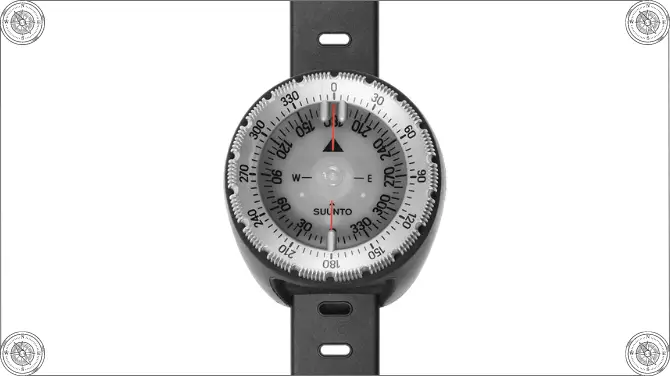
The SUUNTO SK-8 is my second choice for the best wrist compass because of all of the optional ways you can wear it or attach it to your diving gear. Suunto engineering is exceptional. After all, the company has been around for more than 80 years.
Pros:
- One of the world’s most popular dive compasses.
- Easy-to-read numbers on a phosphorescent card.
- Stylish design.
- Waterproof.
- Available in both northern and southern hemisphere versions.
Cons:
- All plastic construction.
- Pricey at $105.
- Occasionally, may get stuck in one position.
Killer Feature: The firm-grip bezel has a ratchet at every five degrees.
This video, produced by Simply Scuba, gives a nice review of the Suunto SK-8.
The features that the reviewer likes are the liquid-filled compass body that is waterproof and the easy-to-read face that can operate when tilted. It works better than many diving compasses.
Buying Options
You will need to have a reliable wrist compass if you want to learn more about GPS for geocaching. An explanation of this process is here.
3. Sun Company ArmArmour 1
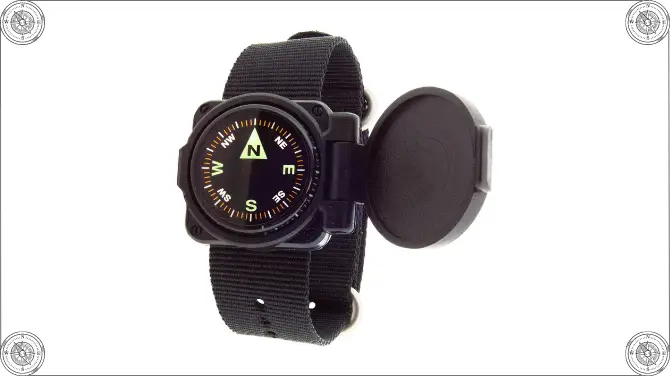
The Sun Company ArmArmour 1 has a classic design with big, easy-to-read markings and a wide Zulu strap. It has a hinged protective cover. It is my choice for a budget-minded person and sells for under $20.
Pros:
- One-size-fits-all 22mm strap.
- Brushed stainless steel hardware.
- Liquid-filled luminous compass.
- Rugged ABS housing.
- Hinged cover.
Cons:
- Needs to be level to work properly.
- Cover may be difficult for some to open.
- Directions for use are confusing.
Killer Feature: Comes with an adjustable strap that fits most adults and children.
This video, produced by REI, shows how to use a compass.
This video is excellent to watch if you have never set up a compass. It shows how to adjust the compass for declination. Declination is the angle difference between true north and magnetic north. Magnetic north is somewhere in northern Canada, not the north pole.
Buying Options
4. Scuba Choice Deluxe
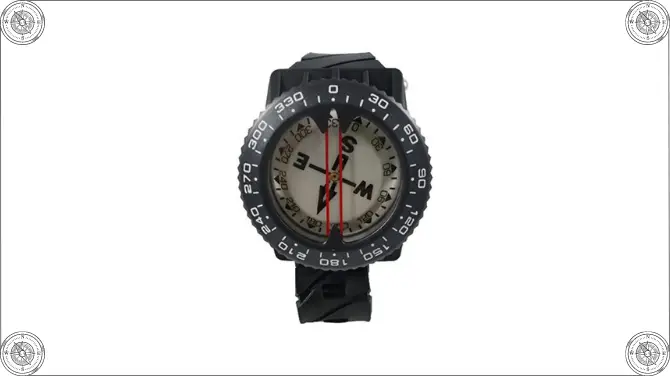
The Scuba Choice Scuba Diving Deluxe Wrist Compass is a diving compass with an easy-to-read dial underwater. It works at a 25-degree tilted angle and a depth of up to 80 meters.
Pros:
- The compass diameter is a very large. It measures two and one-third inches.
- Nice contemporary design.
- Works down to minus five degrees centigrade.
- The strap wrist mount is 15 inches long.
- Good value for around $26.
Cons:
- A bit bulky for use out of the water.
- May arrive with the bezel missing from the package.
- Some have trouble with accuracy.
Killer Feature: This compass works for deep diving with a maximum depth of 80 meters.
This video, produced by Simply Scuba, discusses the importance of using a compass when diving.
The best advice for using a compass is to avoid getting a bit off course and be able to find your way back to the boat. The difference between a compass used on land and one used for diving is that the card for a diving compass is round-shaped to use at an angle.
Buying Options
5. KanPas Diving Sighting Wrist Compass
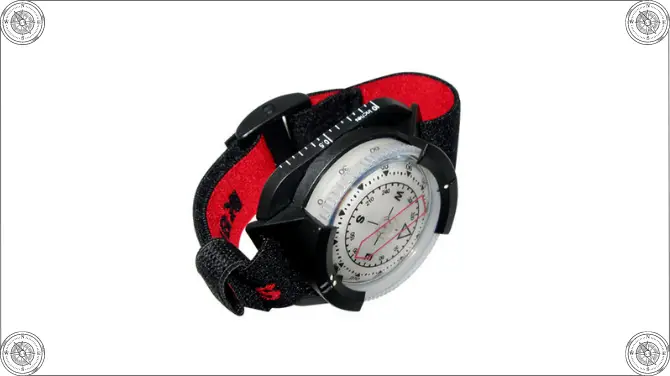
The KanPas Diving Sighting Wrist Compass has a very nice colorful design with black and red for the strap. It has a luminous display and an aiming window to use to determine which direction to go. It is comfortable to wear and looks fashionable.
Pros:
- Shockproof and waterproof up to 60 meters.
- The pointer is stable in most environments.
- It can never become magnetized.
- Offered for a great price at around $18.
- Good for mountaineering and hiking.
Cons:
- May get stuck in position.
- Sometimes is inaccurate if used when tilted.
- Face is too small to read while diving.
Killer Feature: This compass is shockproof and waterproof to a depth of 60 meters.
This video, produced by photofreakalvinz, teaches basic compass navigation for scuba diving.
The video shows how to rotate the bezel, how to make sure the compass card can rotate properly, and how to keep it from getting stuck.
Buying Options
6. Cressi Underwater Compass
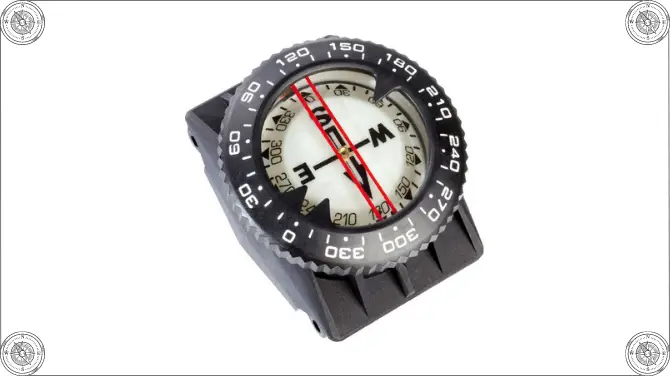
The Cressi Underwater Compass has a design created with a diver in mind. The compass face is 2.36 inches in diameter. The numbers are easy to read while underwater. The luminous face is bright when underwater too.
Pros:
- Italian brand made in Taiwan.
- Has a red lubber line to help with the correct orientation
- Works even if not held perfectly level.
- Has a sighting window for taking bearings.
- Attractive and fashionable.
Cons:
- Compass pointer may swing erratically.
- May stick in place if tilted.
- May give inaccurate readings.
Killer Feature: The face is luminous and divided into 10-degree intervals.
This video, produced by Greatdivers Scuba, shows how to use a compass and when to use the compass when diving.
There are three times when using a compass is useful when diving. The first is to find your way going in the correct direction. The second is if you need to head in a certain bearing direction to locate something. The third is to find your way back to the boat.
Buying Options
7. Sun Company ArmArmour 3
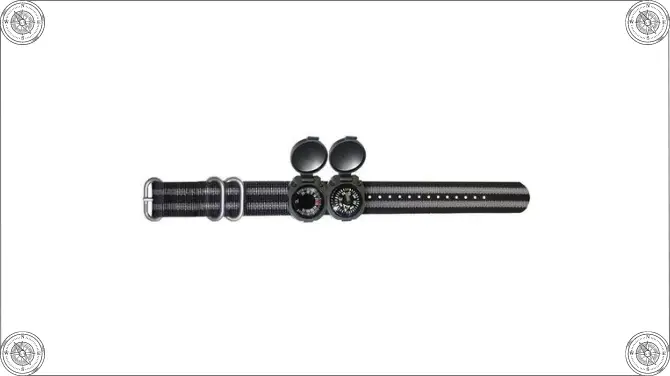
The Sun Company ArmArmour 3 is a shielded wrist compass in combination with a thermometer. There are two hinged covers to protect the devices. It comes in black and black/gray stripes. The adjustable strap fits most adults and children.
Pros:
- 20mm Grade A liquid-filled compass.
- Luminous card that is easy to read in low-light conditions.
- Thermometer reads down to minus 30 degrees Fahrenheit.
- Protective hinged covers.
- Has a rugged, tactical, Zulu strap.
Cons:
- Temperature gauge measures wrist temperature when worn, instead of the ambient air temperature.
- May give an inaccurate reading if tilted.
- Covers maybe difficult to open for some people.
Killer Feature: Comes with a grade-AA dial thermometer that reads down to minus 30 degrees Fahrenheit.
This video, produced by Corporals Corner, shows how to use a compass with a map.
He uses the Suunto MC-2 compass. He shows how to use the bezel ring and find bearings that can help to go in the correct direction to locate something found on a map.
Buying Options
Must-haves
Here are some accessories to use with the best wrist compass.
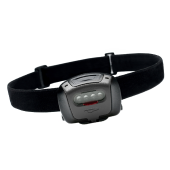 Headlamp
Headlamp
The Princeton Tec Quad Tactical LED Headlamp can help you navigate at night and is waterproof for the depth of up to one meter in case you find yourself lost in a swamp.
 Carry Bag
Carry Bag
The XXL Mesh Dive Bag for Scuba or Snorkeling can help you carry all your diving accessories and is machine washable.
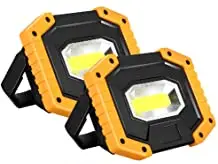 Rechargeable Work Lights
Rechargeable Work Lights
The T-SUN LED Work Light COB is an LED lighting system that runs on rechargeable batteries. The design is durable and waterproof.
Useful Resources
- How does a compass work? →
- How to use a compass →
- Find & improve your location’s accuracy →
- History of the compass →
Final Thoughts
When going hiking or diving, you will want to have the best wrist compass you can take along to make sure you do not get lost. It is very easy to lose your way underwater, especially if the water is murky with low visibility. Even on land, it is quite easy to get lost when in an unfamiliar area. Be sure to choose the compass that is best for your proposed trip and take it along. You will be happy to have it if you need it.

